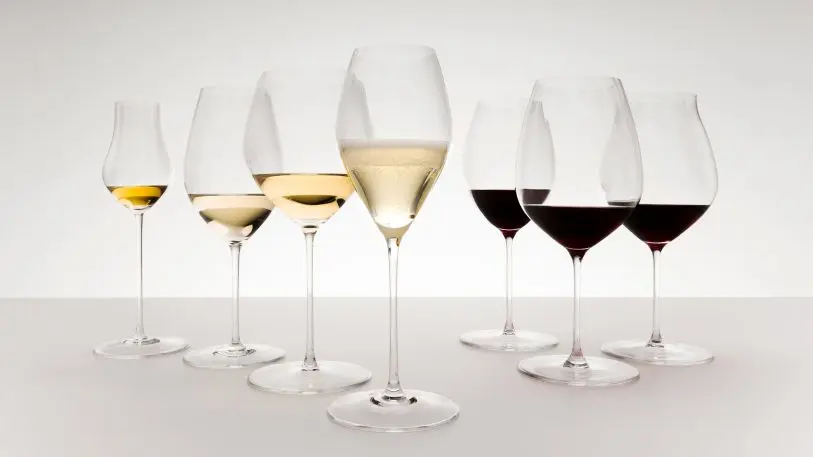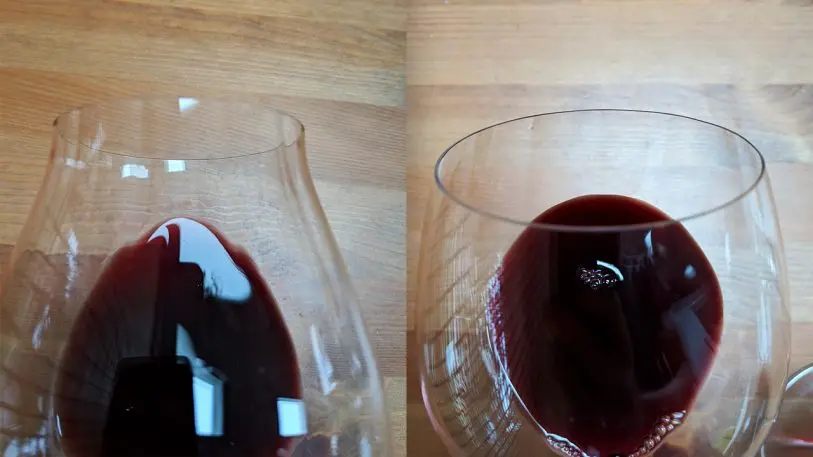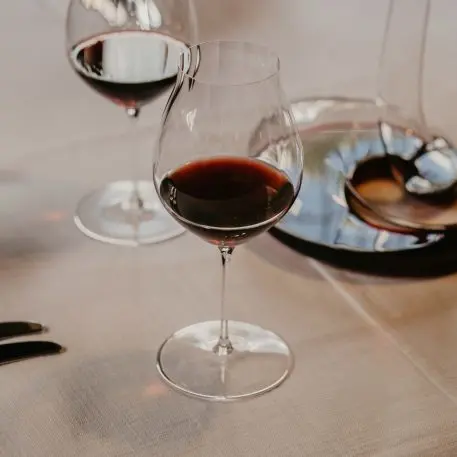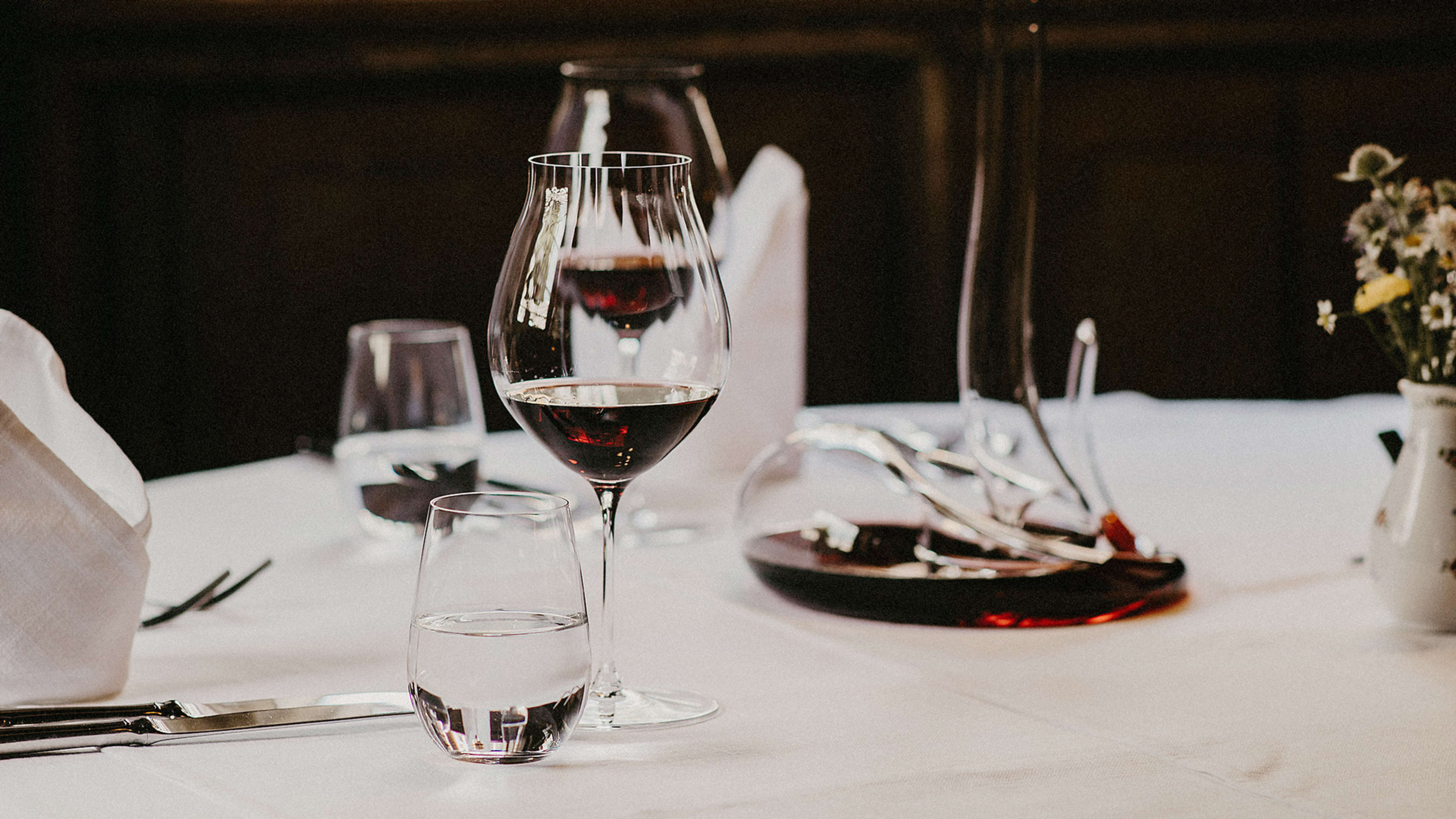I take a sip of wine, and it floods across my mouth–a perfectly balanced cabernet that tastes of yeast, fruit, and stone. Then I take a sip from another glass. This wine strikes the tip of my tongue like a dart. It’s pure booze, and, seconds later, I’m left with a dank, bitter aftertaste. This wine has clearly gone bad; I should really pour the bottle out.
In fact, both glasses contain the same 2014 BV cabernet. And both are what most of us would describe as a “red wine glass.” But the first glass was designed to mellow out the big fruit and alcohol of cabernets. The second glass was built to concentrate the fruit and subdue the acidity of a different kind of wine: pinot noir. I just learned the dangers of drinking a great wine out of a glass designed for another varietal.

You could consider me the ultimate wine snobbery skeptic. I’ve sipped my way through California and Italy, and I buy into the influence of microclimates and terroir. But I’m a firm believer that $100 bottles of wine are for people with too much money, crystal decanters are for people with too much time, and specialty wineglasses are for people with overinflated confidence in their own palates. That a glass could make a $30 bottle of wine taste like a $3 bottle of wine is something I would never have believed before spending an hour tasting with Maximilian Riedel.
Riedel is an eleventh-generation glassmaker and president of Riedel glassware, which just introduced a new line of glassware dubbed Performance, designed specifically for grape varietals like chardonnay, riesling, pinot noir, and cabernet. They feature an unusual base: a small saucer of glass pressed in a machine to a diameter of 10 centimeters and then pulled while molten to create a seamless stem. No other competitor can make a base this thin or wide, Riedel explains, urging that if you ever want to quickly judge the quality of a wineglass, to look at its base. Inside the bowl you’ll find an important innovation: little fins designed to increase the surface area of the glass by a third, which means more of the wine is exposed to air, making it smellable and flavorful.
Riedel likens his glasses to Bose audio equipment, with each glass finely tuned to bring out all the right notes in particular grapes. The shape of the glass bowls–not just the volume, but the diameter on top and the arch of the lip–are used to manipulate the way your mouth meets the glass and how the wine funnels onto your tongue. The effect is like taking an equalizer to wine, turning up and down fruit or acidity by design.
“We do blind tastings at so many competitions, where we take one bottle of wine, and split it into 5, 6, 10 different shaped glasses, and we ask sommeliers a simple question: ‘How many different wines have we poured?’ Never have they been able to say, ‘one bottle,'” says Riedel. “Because we influence everything but the temperature. The texture. The weight. The acidity. The minerality. We can confuse your mind so you, even as a professional, are completely lost.” He has no interest in fooling you–instead, the company wants to autotune your next chardonnay to maximum deliciousness.
They’re beautiful glasses, for sure, but I wanted to put wine snobbery to the test. And as we sipped wine after wine over the course of an hour, Riedel proved to this cynic how the mere shape of a glass can dramatically change your experience of wine.
We begin by tasting a Riesling. I pour it into one glass designed for chardonnay, and another glass made for Riesling. I’m instructed to smell each, deeply. Not just once, but to breathe in and out with my nose deep in the cup, like I’m huffing a bag of paint. In the Riesling glass, I smell pear, citrus, and then a lovely sourdough bread, just out of the oven. In the chardonnay glass, the Riesling literally smells like it’s been watered down. I don’t believe it–the two glasses look so similar–so I sniff each again, but get the same results.
“Chardonnay is much more fruit-forward than Riesling, and tends to be infused with some oak, and alcohol level could be 1-2-3% higher, so we need a bigger opening,” says Riedel. A simpler way of saying that might be, chardonnay is a smellier, more volatile wine than Riesling. Riedel’s chardonnay glass opens itself up to let the subtleties out without burning your nose on booze, but it focuses the scent of Riesling with a narrower rim on that glass.
Next, Riedel has me tilt each glass almost 90 degrees, watching the wine edge toward the rim. I assume, at first, he’s having me inspect the “legs.” He is not! Instead, he tells me to look at the shape of the wine, how it spreads of funnels toward the rim:

“I call it the conveyor belt of wine,” says Riedel. What he’s referring to is that the wine looks something like an egg as it spills into your mouth. But the tip of that egg varies wildly. In a pinot noir glass, the wine hits the rim as a sharp point. Why? The tip of your tongue tastes fruit, and Riedel wants a pinot noir, known for finicky acidity, to strike this area first. For the Riesling glass, that flow point is prominent, but blunted, because the wines aren’t so acidic they need to be as contained on your tongue. And for the cab, the wine spills forward more like a small lake to flood your tongue more evenly. The boldness of sugars, tannins, and alcohol inside cabs benefits from greater deconstruction over your palate, allowing your brain to taste distinct aspects of the flavor.
As I drink the Riesling from the Riesling glass, I realize that I actually arc my tongue to let liquid sit forward. Through a combination of the glass’s shape, and the flow of the wine itself, “You’re sucking the wine from the glass, and it immediately meets the tip of your tongue,” says Riedel. “It’s designed this way! It’s not a coincidence.”
It’s why, as I taste the Riesling in the Riesling glass, it’s a pure, ripe apple on the tip of my tongue–but in a chardonnay glass, it hits the sour-sensing sides of my tongue, burning like a Sweet Tart. Without containing the Riesling to the tip of my tongue where I taste ripe fruits, the wine tastes objectively worse.

“Let me ask you, where do you prefer the wine?” says Riedel. “This is where it gets crazy, because people have a complete blackout, because their favorite wine tastes like crap, or the wine they hated, they now love.”
It would all be hard to believe if the oral contortions the glasses twist me into weren’t so wild. My tongue makes a “V” sipping from the cab glass–how is that possible? While Riedel agrees with modern science that the tongue is a highly misunderstood, relatively dumb instrument, capable of sensing sweet and salty but completely dependent upon your nose for nuanced flavors, what he doesn’t explain is the full domino effect of his glasses; how, when a wine hits certain parts of your tongue, in a certain way, it can actually make you smell new things in it.
“We’ve tried to nail down the science behind it. We were also ready to spend a lot of money on a university study on the topic, but no one is interested,” says Riedel. “We can only describe it by the experience.”
Ultimately, he attributes the company’s design know-how to lessons learned over generations through trial and error. And while I know as well as anyone that such claims sound like wine hogwash, Riedel makes a strong case for giving as much consideration to your glass as that $12 bottle of wine you take 10 minutes to nervously pick off the shelf.
Riedel’s Performance glasses are available now, at the price of $59 per pair. They’re machine washable, and they’re all the same height to sit flush on one shelf. As Riedel is quick to point out, those old glasses from Ikea can be tossed right into your recycling bin.
Recognize your brand’s excellence by applying to this year’s Brands That Matter Awards before the early-rate deadline, May 3.
